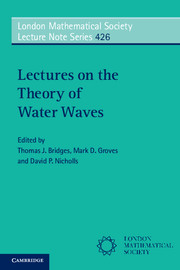Book contents
- Frontmatter
- Contents
- Contributors
- Preface
- 1 High-Order Perturbation of Surfaces Short Course: Boundary Value Problems
- 2 High-Order Perturbation of Surfaces Short Course: Traveling Water Waves
- 3 High-Order Perturbation of Surfaces Short Course: Analyticity Theory
- 4 High-Order Perturbation of Surfaces Short Course: Stability of Traveling Water Waves
- 5 A Novel Non-Local Formulation of Water Waves
- 6 The Dimension-Breaking Route to Three-Dimensional Solitary Gravity-Capillary Water Waves
- 7 Validity and Non-Validity of the Nonlinear Schrödinger Equation as a Model for Water Waves
- 8 Vortex Sheet Formulations and Initial Value Problems: Analysis and Computing
- 9 Wellposedness and Singularities of the WaterWave Equations
- 10 Conformal Mapping and Complex Topographies
- 11 Variational Water Wave Modelling: from Continuum to Experiment
- 12 Symmetry, Modulation, and Nonlinear Waves
- References
12 - Symmetry, Modulation, and Nonlinear Waves
Published online by Cambridge University Press: 05 February 2016
- Frontmatter
- Contents
- Contributors
- Preface
- 1 High-Order Perturbation of Surfaces Short Course: Boundary Value Problems
- 2 High-Order Perturbation of Surfaces Short Course: Traveling Water Waves
- 3 High-Order Perturbation of Surfaces Short Course: Analyticity Theory
- 4 High-Order Perturbation of Surfaces Short Course: Stability of Traveling Water Waves
- 5 A Novel Non-Local Formulation of Water Waves
- 6 The Dimension-Breaking Route to Three-Dimensional Solitary Gravity-Capillary Water Waves
- 7 Validity and Non-Validity of the Nonlinear Schrödinger Equation as a Model for Water Waves
- 8 Vortex Sheet Formulations and Initial Value Problems: Analysis and Computing
- 9 Wellposedness and Singularities of the WaterWave Equations
- 10 Conformal Mapping and Complex Topographies
- 11 Variational Water Wave Modelling: from Continuum to Experiment
- 12 Symmetry, Modulation, and Nonlinear Waves
- References
Summary
Abstract
These lecture notes provide an introduction to the theory of “modulation” and its role in the derivation of model equations, such as the KdV equation, Boussinesq equation, KP equation, and Whitham modulation equations, and their role in the theory of water waves. The classical theory of modulation, such as Whitham modulation theory, will be discussed, and a new approach will be introduced, based on modulation of background flow. Methodology that is key to the theory is symmetry and conservation laws, relative equilibria, Hamiltonian and Lagrangian structures, multiple scale perturbation theory, and elementary differential geometry. By basing the theory on modulation of relative equilibria, new settings are discovered for the emergence of KdV and other modulation equations. For example, it is shown that the KdV equation can be a valid model for deep water as well as shallow water. The lecture notes are introductory, and no prior knowledge is assumed.
Introduction
Modulation is one of the most widely used concepts in the theory of nonlinear waves. In linear theory modulation is normally the process of varying the envelope of a signal. In electronics this concept is expanded further to include digital modulation, analog modulation, pulse modulation, frequency modulation, and so on. In the theory of nonlinear waves it is used to describe “modulation equations,” which typically are nonlinear equations governing the envelope of a wave, although the term is much more widely used now, with any equation on a slow space and time scale called a modulation equation. The term modulation in these notes is closest in spirit to Whitham modulation theory [1]. The idea is that given a basic state, dependent on a phase and a parameter or parameters, the phase and parameters are treated as slowly-varying functions of space and time, and governing equations are derived for these slowly-varying functions.
An abstraction of the idea of a basic state dependent on a phase is a relative equilibrium. A central theme of these notes is modulation of relative equilibria (RE). A definition of RE is given in §12.2. The context throughout will be conservative (Lagrangian, Hamiltonian, multisymplectic).
- Type
- Chapter
- Information
- Lectures on the Theory of Water Waves , pp. 261 - 283Publisher: Cambridge University PressPrint publication year: 2016
References
- 1
- Cited by



